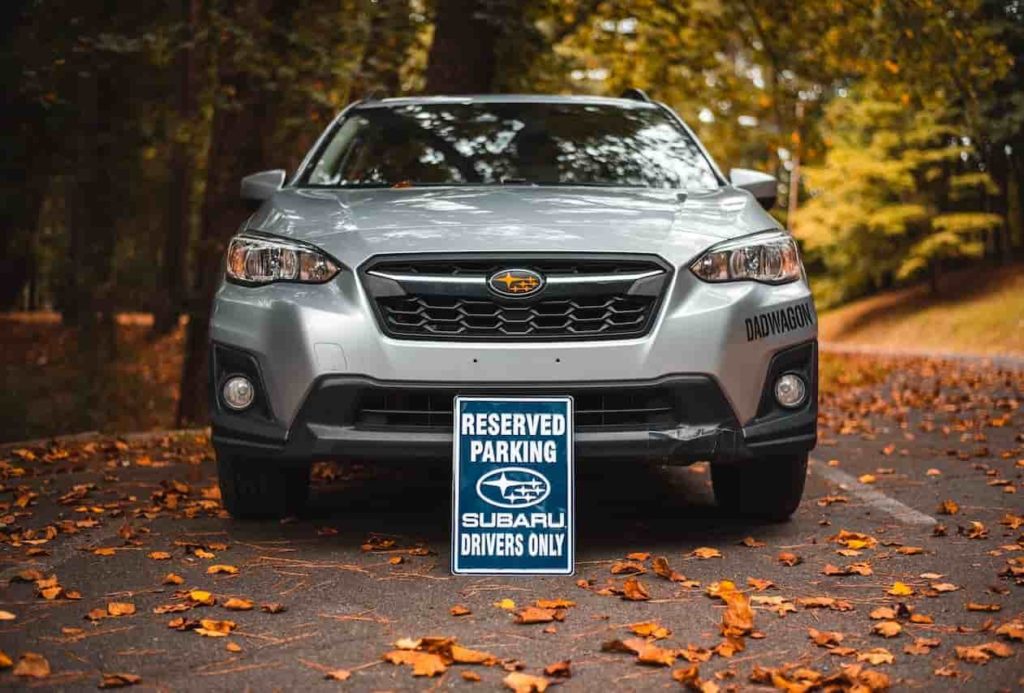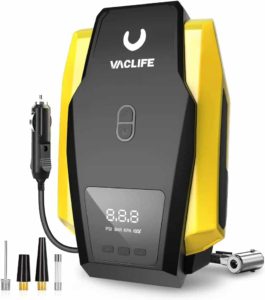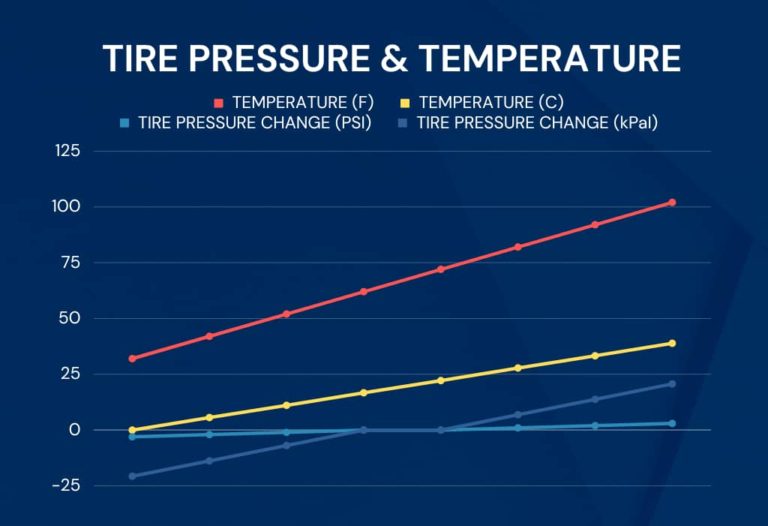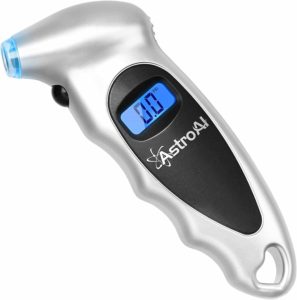The Subaru Crosstrek does not have a reset button to turn off or reset your tire pressure warning light. Don’t worry, and disregard all the articles and videos claiming there is a reset button. We outline 9 simple steps below on how to turn off the tire light in your Crosstrek, as well as how it all works!
What is the Subaru Crosstrek TPMS?
The Tire Pressure Monitoring System (TPMS) in the Subaru Crosstrek is a built-in feature designed to ensure the safety and efficiency of your vehicle. It’s responsible for continuously monitoring the pressure of all your tires. When the pressure in one or more tires drops below the recommended level, the system alerts the driver by illuminating a warning light on the dashboard. To check your current tire pressure: Find the 3 buttons with the up and down arrow on the bottom left of your steering wheel. Use the top or bottom arrow to scroll through a list of screens until you see the tire pressure screen.
Subaru Crosstrek Tire Pressure
TIRE SIZE | FRONT PSI | REAR PSI |
225/55R18 | 33 | 32 |
225/60R17 | 33 | 32 |
SPARE TIRE | 60 | 60 |
Steps to Turn Off Subaru Crosstrek Tire Light
The Subaru Crosstrek does not have a tire pressure reset button.
When the tire pressure light on the dashboard lights up, pull over slowly and check your tire pressure right away.
Determine which tire is causing the tire pressure light to turn on and adjust the tire pressure accordingly. (the TPMS lets you know which tire is low on your screen by displaying the low pressure value in yellow instead of white)
Fill your tire to the exact recommended pressures. I cannot emphasize this enough, accuracy is key.
Drive your Subaru Crosstrek. Drive for 10 minutes at speeds over 20 Mph.
If the light doesn’t go off right away, re-check your tire pressure to make sure they are all at the exact pressure you set them to. If they are down in pressure, you probably have some sort of tire leak.
If the pressures are at the exact pressure you set them to and the tire light still won’t go off, over fill your tires.
We recommend filling your problem tire with 45 Psi or about 10 Psi over the recommended pressure. With the tire overfilled, drive the car again for 10 or 15 minutes. This will turn off the tire light.
Now that the tire light is off, readjust the pressure back to the recommended Psi.
One more option, if you followed all these steps and the light is still on, check your spare tire. Some Subaru’s (depending on the package you have) do have a full size spare with a pressure sensor in them. Make sure your spare tire has 60 Psi. Now drive the car again.
How Does the Subaru Crosstrek TPMS Work?
Sensor Placement: The TPMS in the Subaru Crosstrek consists of four individual tire pressure sensors, one installed in each tire. These sensors are located inside the tire attached to the valve stem. (not visible unless you remove the tire from the wheel/rim)
Pressure Measurement: The sensors utilize a combination of accelerometers and pressure transducers to measure the tire pressure accurately. The pressure transducer converts the physical pressure applied to it into an electrical signal, which is then transmitted to the TPMS module.
Sensor Communication: The tire pressure sensors employ radio frequency (RF) technology to wirelessly transmit the tire pressure data to the TPMS module. Each sensor has a unique identification code to ensure that the correct pressure reading is associated with the respective tire.
TPMS Module: The TPMS module serves as the central control unit for the entire system. It receives the tire pressure data from the sensors and processes the information.
Warning Thresholds: The TPMS module is pre-programmed with specific thresholds for tire pressure. If the pressure in any tire falls below the recommended threshold, the module triggers a warning signal.
Warning Indication: When the TPMS module detects low tire pressure, it activates a warning light on the vehicle’s dashboard. This light resembles an exclamation mark inside a horseshoe.
Display and Notification: In addition to the warning light, the Subaru Crosstrek also displays the actual tire pressure values on the instrument cluster or infotainment system. This provides you with detailed information about the tire pressures in each tire.
Battery Life: The tire pressure sensors are equipped with batteries to power their operations. These batteries have a limited lifespan and are not replaceable individually. Instead, when the battery in a sensor is depleted, the entire sensor unit needs to be replaced. They use wrist watch like batteries but to access them you have to break open the sensor case leaving the sensor broken.
Why is my Tire Light Blinking?
The Subaru Crosstrek also has a different warning system to alert you when something is wrong with the tire pressure monitoring system (TPMS) itself . This warning light uses the same yellow exclamation point as the low tire pressure light. The difference is that, if there is a problem with the TPMS, the light will flash for approximately one minute before staying on. This flashing or blinking will occur every time you start your car until the issue is resolved. This means that when your tire light is flashing or blinking, the system will not be able to detect low tire pressure. Basically, a blinking tire pressure light usually means there is a malfunction within the TPMS itself, rather than an air pressure issue. This is usually due to a defective pressure sensor in one of your tires (a dead battery). To determine which sensor is faulty, use a TPMS diagnostic tool and scan each sensor for diagnostic information. This will also occur if you are driving with your spare wheel on your car. (if the spare does not have a sensor in it)
What Can Cause the Tire Pressure Light to Come On?
Seasonal temperature changes: A drop in ambient temperature can cause tire pressure to decrease, triggering the warning light.
Tire puncture or leak: A sharp object or road debris like a nail or screw may puncture a tire, causing air loss which will of course activate the warning light.
Faulty tire pressure sensor: Damaged or malfunctioning sensors may provide inaccurate readings, resulting in a false alert. The only way to determine which sensor is faulty is to scan each sensor with a TPMS diagnostic tool.
Valve stem issues: A damaged or leaking valve stem can lead to gradual pressure loss and eventual activation of the tire pressure light. They make kits to replace the rubber gasket that usually goes bad.
Tire damage: Impact from potholes or hitting a curb can cause structural damage like tire bubbles, leading to pressure loss.
Sensor battery life: TPMS sensors are battery-powered, and over time, batteries die. (they usually last anywhere from 5-10 years) This will cause the tire pressure light to turn on. Again, you must use a diagnostic tool to determine which sensor is dead or dying.
Recent tire rotation or replacement: If the tires have been recently rotated or replaced, the TPMS may need recalibration to avoid false alerts. Sometimes the vehicle’s computer may think the front tires are in the rear and rear in the front after a rotation.
Wheel or rim issues: Damaged, corroded, or cracked wheels or rims can lead to air leaks and pressure loss. This is very common with low profile tires.
Altitude changes: Climbing or descending in elevation can affect tire pressure and trigger the TPMS warning. An additional 1.5 Psi per Km above sea level is required.
Natural pressure loss: Tires lose air pressure over time due to temperature changes and permeation. Tire dry-rot will happen to tires that sit.
Electrical problems or software issues within the car’s TPMS system. Occasionally the system may have a software update from Subaru.
Snow Tires: If you have a separate set of wheels/rims for snow tires, either swap over the sensors from your summer wheels or purchase a second set of 4 sensors for the second set of wheels/rims. If you are using one set of wheels for both sets of tires, do not worry about this.
What Happens When Tires are Underinflated?
Underinflated tires can have lots of negative side effects on your Subaru Crosstrek, including:
Decreased Fuel Efficiency: Underinflated tires will lower your gas mileage, as they create more rolling resistance, which means the engine has to work harder to keep the car moving.
Poor Handling: Underinflated tires may result in poor vehicle handling and unresponsive steering. This is because the tire doesn’t maintain its optimal shape and provides less traction, making it harder for the vehicle to grip the road, especially in wet conditions.
Strain on Suspension Components: The improper distribution of weight caused by underinflated tires puts additional stress on suspension components, including shocks, struts, and springs. This can lead to premature wear and potential failure of these parts.
Increased Tire Tread Wear: Underinflated tires tend to wear out more quickly, especially along the edges. This can lead to premature tire replacement.
Overheating: Underinflated tires are more prone to overheating because they create more friction against the road. Overheating can lead to tire failure, including blowouts.
Increased Braking Distance: Insufficiently inflated tires require a longer braking distance due to reduced grip on the road. This can be critical in emergency situations where a quick stop is necessary to avoid a collision.
Rougher Ride: Underinflated tires may lead to a less comfortable ride, as they absorb bumps and potholes less effectively than properly inflated tires.
Decreased Load-Carrying Capacity: Insufficient tire pressure affects a vehicle’s ability to carry heavy loads safely. Underinflated tires may not be able to support the intended weight, increasing the risk of tire damage or failure.
What Happens When Tires are Overinflated?
Overinflated tires can also create several problems for your Subaru Crosstrek, including:
Reduced Traction: Overinflated tires have less contact with the road surface, reducing the amount of grip and making the car harder to handle, particularly in wet and icy conditions.
Increased Wear in the Center of the Tire: Overinflation causes the middle section of the tire to bulge, resulting in uneven and increased tread wear in this area. This can also lead to premature tire replacement.
Harsher Ride: Overinflated tires are less effective at absorbing road imperfections like bumps and potholes, also leading to a rougher, less comfortable ride.
Increased Risk of Damage: The excessive air pressure in tires makes them more susceptible to damage from road hazards such as potholes, debris, and sharp objects. This can lead to punctures or tire sidewall damage.
Longer Braking Distance: Overinflated tires will reduce your grip on the road, leading to longer braking distances and compromised stopping power, especially in emergency situations.
Decreased Tire Life: Overinflation can reduce the overall lifespan of your tires, leading to more frequent replacements and higher maintenance costs.
Increased Noise: Overinflated tires produce more noise and contribute to a louder driving experience, as the reduced tire sidewall flex can transmit road vibrations and impact noise more directly. It’s definitely annoying.
How Does the Weather Affect Tire Pressure?
The weather has an undeniable impact on your tire pressure. When it’s cold outside, the air inside your tires contracts. This causes the pressure to decrease. This is why you might notice your tire pressure warning light comes on when it’s cold. On the flip side, when it’s hot outside, the air inside your tires will expand. This causes the pressure to increase. This fluctuation in tire pressure is normal! A general rule to keep in mind is that for every 10-degree change in temperature, your tire pressure will drop by around 1 Psi.
How to Check & Adjust Tire Pressure
Get a high-quality tire gauge.
Make sure to check the tire pressure when the tires are cold. “Cold” means your vehicle has been sitting for at least three hours or driven less than 1 mile in the past 3 hours.
Take off the valve cap from the tire valve stem.
Push the tire gauge firmly onto the valve to measure the pressure.
Compare the pressure reading with the recommended pressure on the tire information label.
If the pressure is lower than the recommended pressure, add air.
If the pressure is too high, let out some air by pressing the metal stem in the center of the tire valve. You can use any object like a screwdriver to do this. Be gentle.
Recheck the tire pressure with the gauge.
Don’t forget to put the valve caps back on to prevent leaks and keep dirt and moisture out.
When Should Tire Pressure be Checked?
To get the most accurate tire pressure reading for your Subaru Crosstrek, it’s best to check and adjust it in the morning or after the car has been parked for a few hours. When you drive, the tires heat up and the air inside expands, giving a higher unprecise pressure reading. So, don’t adjust your tire pressure when the tires are hot, as it won’t be accurate and can cause more problems. For the best results, make sure the Crosstrek has been parked for a few hours before checking the air pressure.
Conclusion
In conclusion, understanding the tire pressure monitoring system (TPMS) in your Subaru Crosstrek is essential for maintaining optimal safety and performance. While the vehicle does not have a tire pressure reset button, we have provided a straightforward step-by-step guide to turning off the tire pressure warning light. So, next time your tire light comes on, don’t panic! Happy Driving! Everything in this article is applicable to all Subaru Crosstrek models and trims. Including, Crosstrek Base, Crosstrek Premium, Crosstrek Sport, and Crosstrek Limited.
Please note that this blog post contains Amazon affiliate links. This means that if you make a purchase through one of these links, we at TPMSRESET.com may earn a small commission at no extra cost to you. We only recommend products that we personally use and believe in. Thank you for supporting us.





